Client’s Best Friend: Leveraging the Human-Animal Bond
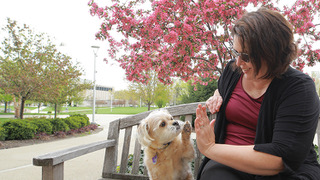
Most of us get a nice warm feeling when we pet a dog or a cat. That action, studies show, releases the hormone oxytocin in our brain, which reduces the stress hormone cortisol and leaves us more relaxed.
But for some social work clients — and mental health patients — being able to experience that connection with their animal on an ongoing basis can mean the difference between relative stability and major depression or even suicide, says University of Toledo social work professor Dr. Janet Hoy-Gerlach (pictured right with her dog, Henderson).
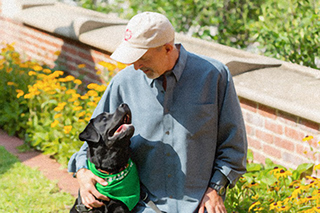
When University of Denver clinical social work professor Philip Tedeschi, MSSW, LCSW (pictured left with therapy dog Samara), was a veterinary medicine student at the University of Wisconsin, he was asked to teach a group of recently deinstitutionalized adults with schizophrenia how to ride horses.
“What I observed was people with a lot of institutionalized behaviors literally changing and becoming more functional, more normative, more talkative, more social right in the very moment they were beginning to interact with the horses,” Tedeschi said.
Shortly thereafter, Tedeschi told his adviser that he wanted to leave vet school and study human-animal interaction, eventually deciding on social work as the best fit.
Animal-Assisted Practice
“Effective incorporation of animals into social work can be as simple as having a dog or cat in the room during a counseling session,” says Dr. Zenithson Ng, clinical associate professor and veterinary social work instructor at the University of Tennessee College of Veterinary Medicine.
“A child might not be open with a brand-new social worker or therapist, but if there is a dog present and the child is invited to tell a story about a dog, for instance, it can help build the trust and foundation," says Dr. Ng.
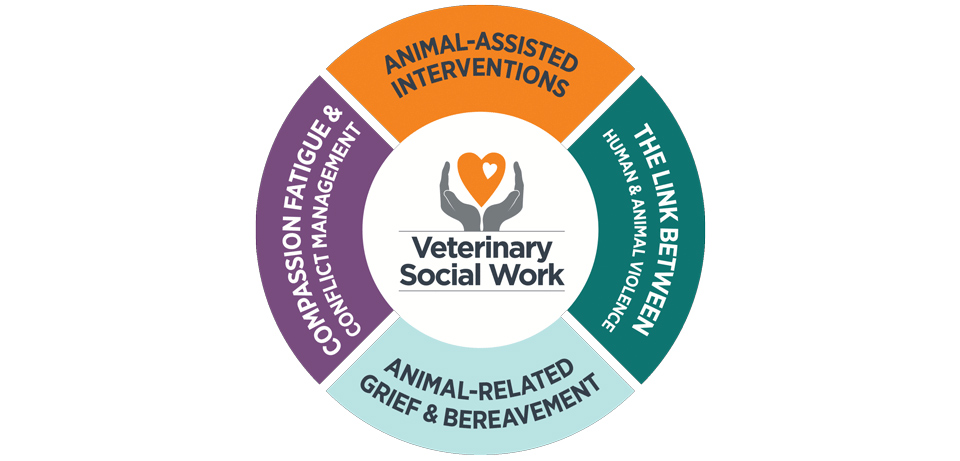
Veterinary social work education at the University of Tennessee has a four-part focus: Animal-assisted interventions; The Link Between Human and Animal Violence; Compassion Fatigue and Conflict Management, and; Animal-related Grief and Bereavement
Unlike service animals, such as seeing-eye dogs, therapy animals—which also tend to be dogs—are trained to help a therapist, social worker or other professional who’s working with a patient or client. Ng’s sister Selina is a social worker who does animal-assisted therapy for a hospice program.
One time, says Ng, she brought her therapy dog to a nonverbal dementia patient, who soon took the animal into his lap and began to talk to it. “The staff members were in shock and disbelief because they had never heard this individual speak before.”
Another valuable asset is the emotional support animal (ESA). This category has gotten a bad rap in the media — with stories about “the peacock on the plane” — but can be vital to people in strife.
Incorporating ESAs is governed by the Fair Housing Act (FHA), and one key task for social workers here is to write an “ESA letter” for the client to the client’s landlord explaining how the animal “helps improve the person’s FHA-qualifying health or mental health condition,” says Hoy-Gerlach.
Learning All About the Human-Animal Bond
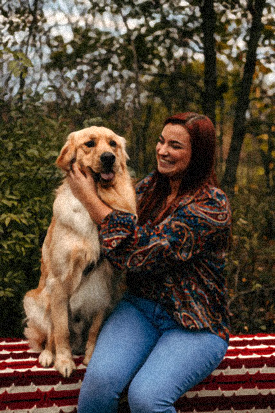
At the University of Toledo, Hoy-Gerlach teaches the elective “Human-Animal Interaction, Health, and Wellness” to both BSW and MSW students.
MSWs can also do their practicum with the Hope and Recovery Pets program, which connects emotional support animals with clients and is a collaboration between the university, the not-for-profit health care organization ProMedica and the Toledo Humane Society.
One MSW student who did was recent graduate Daniela Foley, LSW, who performed monthly phone follow-ups with clients before ultimately being put in charge of facilitating home visits.
Pictured at right: Recent University of Toledo graduate Daniela Foley with her golden retriever, Archie, who serves as a therapy dog at Hospice of Northwest Ohio
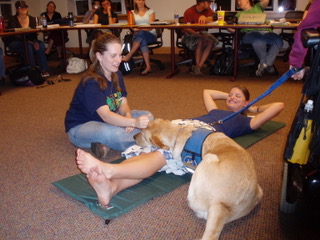
The University of Denver Graduate School of Social Work offers MSW students a certificate called “Human-Animal-Environment Interactions in Social Work,” which includes three required courses. Also, Tedeschi in 2005 founded the school’s Institute for Human-Animal Connection—the first academic center for human-animal bond studies that was not launched by a veterinary school, he says, and “was intentionally designed to work out of the social sciences, social work in particular.” Pictured at right: University of Denver MSW students role-play incorporating a therapy dog into a clinical intervention in which physical contact with the animal helps release stress-reducing oxytocin in the client’s brain.
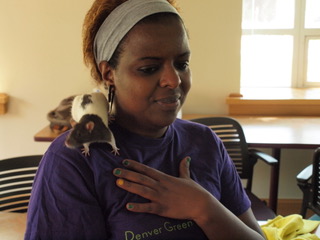
More vet school-focused is the veterinary social work (VSW) program at the University of Tennessee, which has evolved from serving as a subset of social work to being an equal, interdisciplinary partnership between the College of Social Work and the College of Veterinary Medicine, says Dr. Elizabeth Strand, LCSW, the founding director of the VSW program and a clinical social work professor at the veterinary college.
The VSW program offers two certificates—"one for MSW students and one for postgrads.
Pictured above: Emotional support animals can include small “pocket pets” like a hamster, a gerbil or even a domesticated rat (shown). Domesticated rats, says the University of Denver’s Philip Tedeschi, are very inquisitive, resilient, comfortable with human interaction, and are "the cleanest of all of these animals."
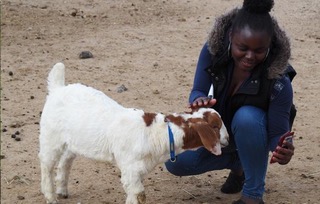
All three schools’ programs promote the idea of “One Health” — the intersection and equal importance of humans, animals and environment, which is why the University of Denver recently added “Environment” to its MSW certificate name, says Tedeschi.
For the University of Tennessee program, says Strand, “One Health has been a core philosophy. Social workers always perceive things from an environmental perspective. Which includes not only the living environment, but also social interaction and access to resources and all the aspects of the environment that we attend to as social workers.”
Pictured above: A University of Denver MSW student interacts at a therapeutic farm interacts with a miniature goat—a species that tends to be exuberant, social and, like other farm animals, particularly effective in the treatment of children, research finds.
Augsburg University: Drilling Down on Diversity
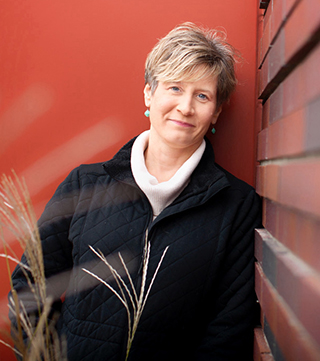
Dr. Christina L. Erickson, professor and Social Work Department chair, talks about Augsburg’s emphasis on “intentional diversity” and how the social work program puts it into practice.
Your university emphasizes “intentional diversity,” but what does that mean exactly?
When we say “intentional” at Augsburg, we are attending to diversity in each of the ways we offer our curriculum, in the way we organize our processes within the university and then also within our programs. So we are ever keen to noticing where we have gaps, where we need to further grow.
How do you go about doing that in the social work program?
It begins with the faculty and staff. We model affirmation and respect, which is asked of us by the Council on Social Work Education. So we have to model that for each other and do it within the classroom as well. Then we try to further transfer that to the student experience by having some “high-touch” moments throughout students’ academic experience. For example, we’ll hold welcoming events for our students at the beginning of the semester, making sure faculty and staff are all there and getting to know each student as the human being they are in all their diversity.
And how is intentional diversity instilled into the curriculum?
One way is it’s built right into courses and fieldwork, where students can sit down with a small group of other students and a faculty facilitator and begin to understand their own levels of human diversity. And we’re required to think about diversity beyond the Big Two—race and gender—and go much deeper into faith traditions, ways of thinking, political ideologies, and really help students see the diversity and intersectionality within their own selves.
University of Oklahoma: Intervening Sooner on Substance Misuse and Suicide Risk
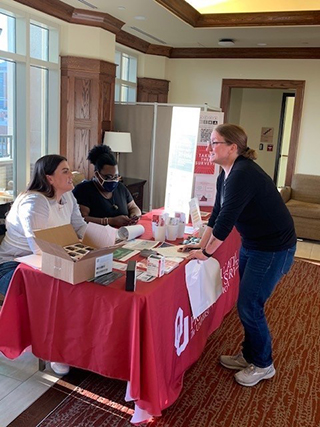
Air Force veteran Dr. Jovanna Gaines, LCSW, BCD-Social Work, recently drew on her experience in military mental health and drug use counseling to help launch the four-year Higher Education Prevention Services (HEPS) program at the University of Oklahoma’s Anne and Henry Zarrow School of Social Work.
Its mission is “to get information about substance abuse and misuse out there, educate the community so we can prevent any dangers from misuse,” says Gaines, who is the program coordinator and a social work instructor.
Pictured at right: Social work practicum students represent HEPS at a University of Oklahoma health event in April.
HEPS does this, Gaines says, through social media platforms like TikTok and Instagram, setting up tables at health fairs, and partnering with some 30 university departments and campus organizations. Among them are the Goddard Health Center, the Southwest Prevention Center, and student organizations like fraternities and sororities. One recent effort, for example, directed people to the federal Drug Enforcement Agency’s “One Pill Can Kill” campaign, which targets methamphetamines, fentanyl and other drugs.
HEPS is sponsored by the Oklahoma Department of Mental Health and Substance Abuse Services (ODMHSAS), says HEPS Principal Investigator Jennifer Dell, LCSW, LADC, instructor and director of undergraduate programs for the Zarrow school.
“ODMHSAS uses some state funds and federal funding from SAMHSA (Substance Abuse and Mental Health Services Administration) to support this initiative focused on stimulants, opioid misuse and suicide prevention,”
Dell says.
Four students — two BSW and two MSW — are helping out at HEPS this school year as part of their practicum. And in November, Gaines and Dell will work to widen HEPS’ audience by giving a presentation at the Council on Social Work Education’s national conference in Anaheim, Calif., called “Intervene Sooner: Increasing Awareness of Substance Use and Suicide through Campus-based Preventive Strategies.”